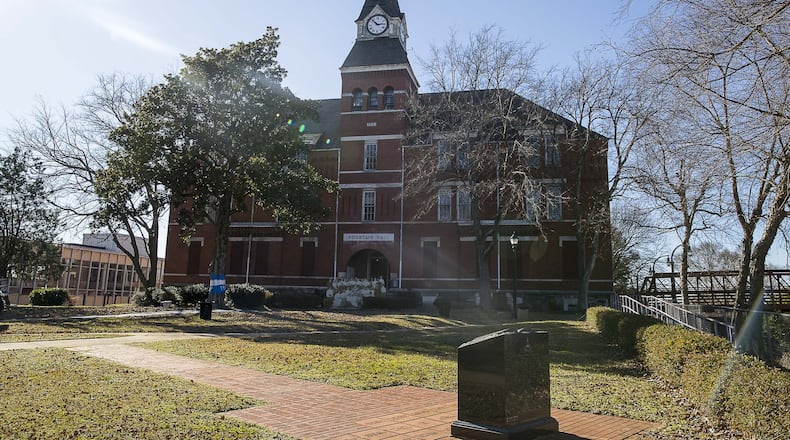Melva Robertson always knew she wanted to follow in mother’s footsteps at Morris Brown College.
A generation after her mother joined the marching band, pledged Alpha Kappa Alpha sorority and served as the first attendant to the reigning Miss Morris Brown, so did Robertson.
She even took her first class, freshman English, in the same ground floor classroom of Fountain Hall that her mother did in the early 1960s.
“Fountain Hall is the heart of Morris Brown College,” said the 2001 graduate, “and Brownites all over have passed through the halls and floors as a rite of passage.”
But it’s been more than a decade since anybody has really walked through the now dusty and dark corridors of Fountain Hall, which opened with great fanfare in 1882 as a symbol of black educational promise.
Few landmark buildings in Atlanta are as grand as Fountain Hall. And few are as neglected.
Since Morris Brown lost its accreditation in 2002, the building — the focal point of the college founded by former slaves — has sat fallow and dying. The Georgia Trust for Historic Preservation recently put Fountain Hall on its list of “Top 10 Places in Peril.”
Slowly, that situation might be changing.
Earlier this year, the National Trust for Historic Preservation gave Morris Brown $75,000 to develop a strategy to restore Fountain Hall.
And last month, as part of a $12 million National Park Service initiative to preserve institutions that have played a key role in telling the African American story of equality, Morris Brown was awarded $500,000. That money will go toward the renovation of Fountain Hall, declared a National Historic Landmark in 1974 because of its significance to American education.
“When I walk into this building, I think about history, perseverance, legacy and the iconic symbol of what Morris Brown represents,” said the school’s president, Kevin James. “Morris Brown is the only black college founded in Georgia by black people, so this building means so much to so many people. We have to make sure that it is saved.”
Those initial steps would including fixing the roof to prevent water damage, installing a fire alarm system and removing old carpets.
In its 177-page study, the National Park Service estimates that it will take at least $1.4 million to get Fountain Hall to a safe structural level to begin long-term preservation, which would cost millions more, meaning that Morris Brown officials still have a lot of work to do.
Separately, James said the school has raised about $1 million since March as part of a $15 million capital campaign for the school, which he is trying to get accredited with the Transnational Association of Christian Colleges by 2020.
“Atlanta has a way of razing important structures that tell the story of the history of the city, especially African American communities,” said 1976 Morris Brown valedictorian Clarissa Myrick-Harris, whose parents met on campus in the late 1940s. “When you erase these physical structures, people get amnesia and forget the role they played. Fountain Hall is so important because it is a physical embodiment of the profound history of black Atlanta.”
A building on the hill
Fountain Hall — from the day it opened, just 17 years after the end of slavery — has always stood out with its Richardsonian Romanesque style with Queen Anne style features.
It was initially known as Stone Hall, on the campus of what was then Atlanta University.
The three-story, red-brick building was built atop Diamond Hill, one of the highest points in Atlanta, and was used by Atlanta University primarily as an administration building, chapel and library.
Thousands of students attended classes, recitals, religious services and rushed sororities in the building, where an ancient bell on a four-sided clock chimed hourly.
“It all goes back to this idea of African American education being prominent in the city’s history,” said Doug Young, assistant director for historic preservation for the City of Atlanta’s office of design. “If you think about that as a cornerstone of the city’s history, it builds to what the city is today — success over struggle. When they built that building, they were making a purposeful effort to be successful.”
Between 1897 to 1910, in his first stint as a professor at Atlanta University, W.E.B. Du Bois maintained an office in Fountain Hall, where he wrote “The Souls of Black Folk,” considered by scholars a cornerstone for African American literature and critical thought.
Morris Brown, which was chartered in 1885, moved to the original Atlanta University campus in 1932.
When Morris Brown’s accreditation was revoked by the Southern Association of Colleges and Schools for ballooning debt and financial mismanagement in 2002, it didn’t just lose students. Buildings like Gaines Hall and Furber Cottage burned down. Others, like the Towers, which was the main dormitory, have been torn down. The football stadium, built to host soccer during the 1996 Olympics, sits like a white elephant.
Fountain Hall, the science building and the administration building, which is the only one still in use, are the three remaining buildings on campus.
They sit alone among the rubble and boarded up and burned-out buildings. Just 35 students attend the college.
“Sometimes, I avoid driving down MLK so I don’t have to look at the buildings. I don’t say that to say I am disgusted. I am just sad,” said Myrick-Harris, who taught at Morris Brown from 1998 until 2003 and now chairs of the humanities division at Morehouse College. “Other times, I drive and feel hopeful that it is still here. I see the clock and there is a sigh of relief that it hasn’t been destroyed and a hope that it can make a comeback.”
Falling down, but “not that bad”
Earlier this month, a maintenance man opened up Fountain Hall for James, the college’s president, and architect Susan Turner. As the worker pulled apart two massive front doors, secured by a heavy chain, a stiff chill, mixed with dust and the smell of mold and mildew, hit the faces of James and Turner.
A huge Lee Ransaw mural in the entryway remains in pristine condition, despite everything crumbling around it. Years of water damage and exposure have left exposed bricks and carpets covered in fungus.
Mold and mildew have crept up once-white walls that are still lined with 2003 party fliers and a SpongeBob SquarePants movie poster. In the once-grand chapel, the cracked stained glass windows offered a soft glow over a destroyed piano and organ.
Parts of the roof have separated from the walls. Along the bottom floor, mortar has been completely washed away from the bricks.
None of that fazes Turner, who has extensively studied the building. She talked to James about the history of the building’s character-defining features, like the intricate use of stone, arched entryway and, of course, the bell and clock tower.
Standing in the middle of a nondescript cluster of offices, she closed her eyes and visualized how it as the school’s library, before it was compartmentalized. Because most of the ceiling tiles have fallen, she can look up at the original high wood ceilings and arched doorways that had long ago been plastered over in the name of progress.
“All and all, ” Turner said, “the building is not that bad right now.” But, she warned, all bets are off if the roof isn’t soon fixed to stop further damage.
“A building like this, you just walk around and you feel the history. You work on buildings like this enough and you see what can be accomplished,” Turner said. “Even things that look really far gone can be brought back. This building can be special again if it is rehabilitated.”
James quickly interjected and promised that he will raise the money to do it.
Based on early estimates, even after the building is stabilized, it could cost another $30 million to restore it to use.
"Not if it is rehabilitated," James said. "When it is rehabilitated."
Built from resiliency
Robertson didn’t make it to homecoming this year, but she tries to take her 8-year-old daughter Aria on campus as much as possible.
“There is a sadness that the school isn’t what it once was,” Robertson said. “But when I look at it, I still see the frats and the sororities out on the plots and the kids crossing the bridge. There is a spirit that still looms over that place.”
But there is also a quiet reality because of the school's uncertain financial and academic future. Unlike her mother and grandmother, Aria might never follow their footsteps to Morris Brown, much less toward Fountain Hall.
“Morris Brown is built from resiliency, so I believe that it is totally possible that the school can be restored,” Robertson said. “However, if it turns out that there is another path in store for my daughter, I am fine with that because the spirit of Morris Brown College is still in her.
“She comes from a legacy of Brownites, so she will learn excellence, character, integrity, intellect and perseverance from us and take it wherever she chooses to go.”
About the Author
Keep Reading
The Latest
Featured












